As Americans start to rediscover their place in a (largely) post-pandemic world, hospitalists across the country are resuming and recommitting to a variety of extracurricular roles and responsibilities beyond their scheduled shifts on the hospital floors.
As we celebrate 2023 National Hospitalist Day on March 2, taking a peek into the future of hospital medicine, we offer you brief accounts of some of the roles 10 hospitalists are playing to advance the field, helping better to define its range and extent, improve quality on multiple levels, and commit to advancing diversity, equity, and inclusion in the care of hospitalized patients.
A clear path to a hospitalist career
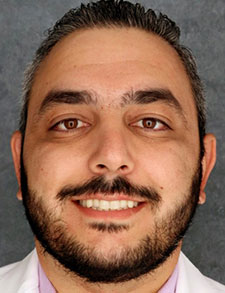
Dr. Namavar
Hospitalist Aram Alexander Namavar, MD, has approached his career in hospital medicine with a vision of what he wanted to do, how to get there, and the skills he needed to reach his goals. Along that journey, he has looked to SHM for opportunities to learn, network, contribute, and lead, starting as a recipient of a 2016 Student Hospitalist Scholar Grant while still a medical student at Loyola University in Chicago. Every step of the way, he’s found opportunities to contribute to the larger field of hospital medicine while advancing his own career.
Dr. Namavar joined SHM’s Physicians in Training (PIT) Committee, helped to found and lead its Resident and Student Special Interest Group (SIG), created a mentorship program connecting trainees with working hospitalists, and played active roles in SHM local chapters in San Diego—where he completed his residency at the University of California, San Diego—and now in Los Angeles, where he’s a first-year attending at Cedars-Sinai Medical Center.
“I was exposed to hospital medicine as an undergraduate at UCLA,” Dr. Namavar said. While pursuing a graduate degree before applying to medical school, he became a mentee of Nasim Afsar, MD, MBA, MHM, an SHM past president, and now chief health officer at Oracle Cerner. With Dr. Afsar’s encouragement, he took on a quality improvement project within UCLA’s department of medicine.
“I have a lot of ideas I want to pursue. I have tried to be very purposeful about all the activities I choose to do,” he said. “To be honest, it was the encouragement of my mentors, staff at SHM, and others along the way that helped me clarify what I needed to do to become a hospitalist.”
He is now focused on honing clinical skills and experience during his first year at Cedars-Sinai, to become the best doctor he can be. But he looks forward to adding layers of non-clinical, practice-focused skills to his repertoire.
“It’s important for future doctors to recognize that hospital medicine can be a very supportive field, with lots of resources,” Dr. Namavar said. “I always tell them, if they are interested in something, just ask a hospitalist.”
The art of mentoring
For Lauren Spaeth, a fourth-year medical student at Ohio University Heritage College of Osteopathic Medicine’s Dublin, Ohio campus, the early days of the COVID-19 pandemic turned her medical training upside down. As described in her December 4, 2021, posting in SHM’s The Future Hospitalist Round-Up, Spaeth lost in-person interactions with classmates and teachers and almost all face-to-face encounters with hospitalized patients.
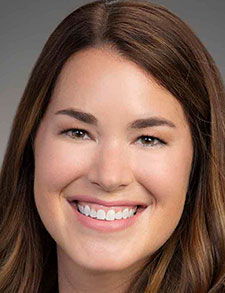
Ms. Spaeth
Instead, she pursued the remainder of her first year and all of her second-year studies in relative isolation, with virtual classes, training videos, and online review materials. “The dimension of human contact was suddenly taken away from me,” Ms. Spaeth said. In the third year, she resumed in-person clinical rotations and started applying the knowledge she had been learning virtually to real patients.
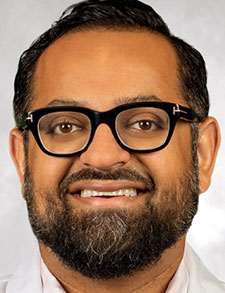
Dr. Patel
“As an educator who oversees medical students and residents, I have a lot of mixed feelings about the impact of the pandemic on hospital medicine,” said Sanjay A. Patel, MD, FACP, SFHM, @buckeye_sanjay, associate program director for internal medicine for OhioHealth’s Riverside Methodist Hospital in Columbus, a member of SHM’s PIT Committee, and Ms. Spaeth’s mentor.
Ms. Spaeth met Dr. Patel during a summer research externship program between her first and second years of medical school. “Lauren would come once a week and observe rounds with my team,” Dr. Patel said. “She was inquisitive about the clinical issues.”
Ms. Spaeth described how a mentoring relationship formed from that experience, out of recognition of their shared interests in clinical medicine and approaches to patient care. Dr. Patel has continued to mentor her, which contributed to her success in applying for residency and securing interviews.
“My relationship with Dr. Patel also fueled my involvement in SHM, which has been a springboard for new opportunities,” Ms. Spaeth said. Mentoring is not something that’s taught in medical training—how to be a good mentor or mentee. “There’s also a shared understanding in medicine that you’re supposed to give back. Dr. Patel has modeled that for me, and I look forward to doing the same in the future.”
Maintaining momentum for networking in a pandemic
Meera Udayakumar, MD, SFHM, executive medical director for quality and innovation for the University of North Carolina (UNC) Health Triangle East in Chapel Hill, N.C., has been a hospitalist since 2008, eventually becoming the medical director for hospital medicine at UNC Rex Hospital in Raleigh, N.C.
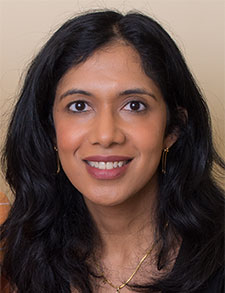
Dr. Udayakumar
“I saw how hospitalists can and should play a key role in hospital performance improvement. There are multiple projects for which hospitalists are the subject matter experts.” She is also the medical director for UNC Health’s Hospital at Home Program, which went live in 2021 and has cared for more than 750 acute inpatients in their own homes.
In April 2020, Dr. Udayakumar became president-elect of the North Carolina Triangle chapter of SHM, a role that includes responsibility for coordinating the chapter’s annual local RIV (Research, Innovations, and Clinical Vignette) competition. “When I took on that position, chapter activities had been sidetracked by the pandemic crisis. But it became clear that for many hospitalists, it would be helpful to work on something non-COVID-19 related, such as our very engaging RIV competition.”
The chapter’s leadership agreed to convert the competition to a virtual format. Dr. Udayakumar put out a call for abstract submissions and recruited judges. Participants were invited to prepare an electronic poster submission for display in a virtual poster hall, and the top five submissions were judged during an online chapter meeting.
“There are many benefits to RIV for those who participate. It’s a great way to learn how to produce abstracts and posters, plus great fun to share your work,” she said. “There are universal problems in hospital care and it’s good to see how others are addressing those problems and then to take those learnings back to your own group.”
The N.C. Triangle Chapter is about 250 members strong. The 2020 competition that Dr. Udayakumar oversaw generated the group’s greatest number of submissions and posters to date. But she doesn’t take credit for that outcome because the pandemic was driving the need to reconnect with hospitalist colleagues locally. “I changed the format of the competition to virtual but tried to keep the momentum from past years.”
A local flavor to networking
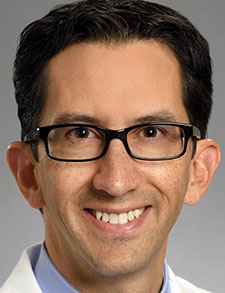
Dr. Vazquez
John Vazquez, MD, @JohnVaz06707022, associate director of operations in the division of hospital medicine at Emory University School of Medicine in Atlanta, is a past president of SHM’s Atlanta Chapter and chair of its District 5. In 2024, he becomes the chair of the Society’s National Chapter Support Committee, which helps hospitalists come together with their peers in local chapters and offer something both social and educational.
“It’s good to go to a local meeting with your peers on a Wednesday night, have a nice glass of wine and talk about afib—or about the problems we all share,” he said. That’s also an important way to grow the national society from the grassroots level and hear what frontline hospitalists are thinking.
At the national level, hospitalists can go to SHM meetings and visit its website. “But the local chapter comes to you and listens to your needs. It’s not just about hearing an academic lecture,” he said. It’s also about offering support, especially when burnout has robbed many hospitalists of the joy of practice and made them forget why they ever became a doctor. “At the local level, we can push this kind of support. Doctors can see an educational talk and go home reinvigorated.”
This is a year of hope, Dr. Vazquez said. “Back in 2020, everyone was in a tizzy from the pandemic. Now people want to reestablish who we are and how we practice and try to be on top of what’s coming next. People are thinking about their careers again.”
Some of the best chapter talks are about practice—not just clinical medicine, Dr. Vazquez said. Others take creative approaches like a Jeopardy-style quiz show—with a commitment to make sure it’s fun. For Dr. Vazquez, an important priority is not just to support the existing chapters but to think strategically about the creation of new SHM chapters in communities that never had one, using the society’s regional structure of 12 districts and supportive volunteers. “If you partner with a local group, once they’ve presented their first meeting, they’re on their way.”
Understanding the demographics of hospital medicine
Damian Crawford, MD was an academic hospitalist at Johns Hopkins Bayview Medical Center in Baltimore, when he opted to leave the academic world for a group-practice leadership position in a community-hospital setting. So, in 2019 he took a job with the national hospitalist company Sound Physicians as chief hospitalist at Frederick Health Hospital in Frederick, Md. There he leads a group of 20 full-time physicians and two advanced practice providers. He also directs the hospital’s observation unit and works closely with emergency medicine and critical care.
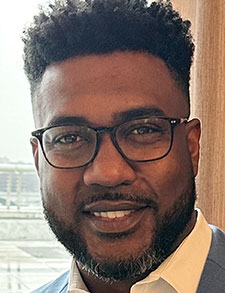
Dr. Crawford
Dr. Crawford was invited to join SHM’s efforts to advance diversity, equity, and inclusion (DEI) in hospital medicine as co-chair of its DEI Task Force, which in November of 2021 was elevated to a formal committee of the SHM Board of Directors. “The purpose of the DEI Task Force was to point SHM in the direction we believe it should go in promoting greater diversity for the field,” he explained. This body itself has a diverse membership from across the country and meets monthly virtually to work on a variety of projects.
“DEI is such a broad subject. What can one health care organization do?” Dr. Crawford posed. “For me personally, I don’t believe America has enough Black men in medicine, making up less than 3% of physicians. Someone else might say we don’t have enough women in leadership positions in medicine.” And this lack of diversity has negative real-life consequences in terms of outcomes such as higher mortality rates for Black patients.
“We spent a year brainstorming, and we saw that we didn’t have good demographic data on the hospitalist workforce.” So SHM initiated a process to start collecting demographic data as part of an updated member profile.
Dr. Crawford credits SHM’s commitment to diversity at a time when the health care system has finally acknowledged the need to do better in this area. The DEI Committee includes SHM CEO Eric Howell, MD, MHM, and board member Flora Kisuule, MD, SFHM, director of the division of hospital medicine at Johns Hopkins Bayview Medical Center in Baltimore. “That signals its seriousness as an organization and shows its commitment to these issues,” he said.
But how quickly can that buy-in change the face of hospital medicine? “I am very much aware that real change is not going to be quick,” he said. With efforts like SHM’s DEI Scholarship Fund, sponsored by Vituity, which awards a $25,000 scholarship to an underrepresented third-year medical student, and other mentoring programs and connections, it can help to develop a more diverse pipeline of future hospitalists, Dr. Crawford said.
A transitional role in hospital medicine
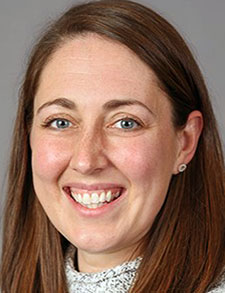
Dr. Peterson
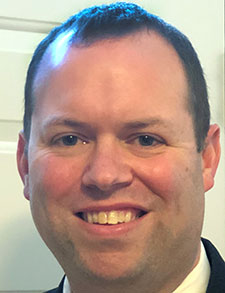
Dr. Fish
“Med-peds” occupies a unique role in hospital medicine, said David Fish, MD, SFHM, assistant professor of medicine and pediatrics at UMass Chan Medical School, Worcester, Mass., and Rachel J. Peterson, MD, @MPAcadHosp, assistant professor of clinical medicine and pediatrics and a hospitalist at Indiana University School of Medicine in Indianapolis. They are the chair and vice-chair, respectively, of SHM’s Med-Peds SIG, which represents hospitalists who have completed a four-year residency combining both pediatric and adult medicine and are thus qualified to care for patients across the age spectrum.
Dr. Fish said the Med-Peds SIG’s top priority is to represent this niche specialty at the national level. “We advocate for career support and education for early career hospitalists and trainees.”
“I find that often the interests of med-peds doctors around the country align around the needs of their patients who are adolescents or teens, who have complex conditions, and who are in the midst of a difficult transition from pediatric to adult medicine,” Dr. Peterson said. “My hospitalist practice covers the entire age spectrum, but it is evolving. I have become an advocate in adult medicine for our patients who are adults but still getting care at the pediatric hospital.”
Dr. Fish, who also helps to lead the Cystic Fibrosis Center at UMass, divides his time between inpatient adult medicine and inpatient pediatrics, with a small outpatient cohort. “A lot of people with our specialty carve out their own clinical niches in various ways.”
Med-peds doesn’t have a single professional home. “Doctors may look to different medical societies as their primary representative body, although SHM is where many of us feel most at home,” he said. The recent development of fellowships for pediatric hospitalists adds to the complexity of the field. SHM has worked with the National Med-Peds Residents Association on a program exploring whether fellowship is the right path for trainees and young hospitalists.
But there seems to be growing interest in med-peds’ dual role—judging by job postings. That may reflect how during COVID-19 viral surges some pediatric doctors were assigned to adult hospital responsibilities—despite a lack of training in adult medicine. “I’ve seen hospitals become more aware of the benefits of a more agile workforce,” Dr. Peterson said.
“We are a group of clinicians that can have a unique skill set,” Dr. Fish said. “That’s been highlighted in recent years by how adaptable we can be. That’s where we stand out. In the last few years, we have highlighted the value the med-peds hospitalist can bring to an institution, as well as to hospital medicine as a whole.”
The excitement of public policy
Sarah Johnson Conway, MD, is a hospitalist at Johns Hopkins Hospital in Baltimore, chief medical officer of the Johns Hopkins Clinical Alliance, and assistant professor of medicine at Johns Hopkins University. The time she has spent working on issues such as acute care utilization, safe transitions of care out of the hospital, partnerships with federally qualified health centers, and value-based care strategies for Johns Hopkins Medicine sparked an interest in how health policy decisions get made and how hospitalist advocates can contribute to those decisions. That interest led her to join SHM’s Public Policy Committee.
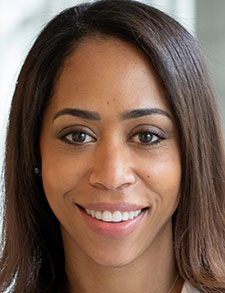
Dr. Conway
In addition to monthly Zoom meetings, SHM’s committee convenes an annual “Hill Day,” when members go to Congress to meet with their legislators. “It is an opportunity to share the critical role and purpose of hospitalists,” Dr. Conway said. “People sometimes get confused about what a hospitalist is, but now, in part due to the pandemic, there is a broader appreciation that we really are an essential part of the health care delivery system.”
Serving on the Public Policy Committee has been an exciting opportunity to meet and learn from other hospitalists. “I have gained a lot of insights from my colleagues,” she said. Some of the challenges they face are the same, and some are unique to their particular hospital and regional setting, she said.
Other policy issues that hospitalists should care about include the (temporarily waived) requirement for Medicare patients to spend three midnights in the hospital to qualify for discharge to a skilled nursing facility; prior authorization policies employed by Medicare Advantage plans; and the X-waiver that required physicians to complete a lengthy training to be able to prescribe buprenorphine for opioid use disorder. SHM, working alongside other medical groups, just successfully advocated getting the X-waiver requirement rescinded.
After a challenging couple of years during the pandemic, Dr. Conway said, now is a great time to be a hospitalist. “I feel ever more appreciated based on the key role we played through the pandemic. It brought our efforts to the forefront and strengthens our position for effective advocacy.”
Burnout’s buckets
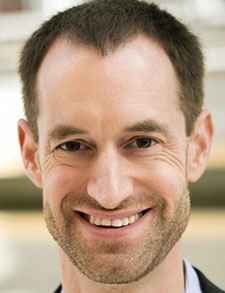
Dr. Pierce
Read G. Pierce, MD, division chief of hospital medicine and associate chair for faculty development and well-being at Dell Medical School at the University of Texas in Austin, has been a career hospitalist for two decades. He chose that path while finishing residency because of how the specialty combined clinical work with a focus on improving health systems.
But after the first two or three years, Dr. Pierce was experiencing profound burnout in his work. “I didn’t have a name for it. But it caused me to question whether I even wanted to continue to be a clinician. It was a real existential dilemma.”
What enabled him to turn the corner on that existential crisis? Lots of little things, he said. “But the big thing that made a difference for me was when a mentor who could see what was happening to me asked me to give a talk to his hospitalist leadership development course on how physicians can avoid burnout and find a better sense of thriving in their work. Thankfully, I wasn’t so burned out that I turned down his offer,” he said. “I went to the medical literature to study what it said about burnout.”
That assignment sparked a deep interest in the topic for Dr. Pierce. “I didn’t want other clinicians to go through what I experienced.” He has since given that talk to physician audiences dozens of times. In the early stages of the COVID-19 crisis, when a lot of clinicians—hospitalists in particular—were suffering from extraordinary levels of stress and long hours, he joined SHM’s Hospitalist Well-Being Task Force, which has developed a comprehensive toolkit on the subject.
The burnout literature has identified three main “buckets” that help clinicians understand burnout and its remedies, Dr. Pierce said. All of these are covered by SHM’s Hospitalist Well-Being Advocates Toolkit, with practical tools and other guidance for clinicians. They include personal resilience—“things I do for myself”; the role of the culture of medicine and the local environment in lifting people up or dragging them down; and efficiency of practice and other system factors that impact how much energy must be put into delivering high-quality patient care.
Although things are changing in medicine, there still is a need for further culture change, he said. The culture is still heavily invested in calling out mistakes but not telling doctors when they’re doing a good job—assuming that they get sufficient intrinsic satisfaction in their work. “We also select people for medical school who have strong drives to self-critique and relatively low levels of self-compassion. But now people coming into the field are asking questions and pushing back on the need to promote more sustainable practices,” he said.
Where is the field today when it comes to preventing burnout? “Honestly, the answer is not clear,” Dr. Pierce said. “I feel we are on the cusp of using the pandemic as a trigger for post-traumatic growth. But that being said, the pandemic was extraordinarily hard on our field, which was at the front lines for surge after surge. Hospitalists have a long history of being innovators, and we’ll need to harness that spirit to achieve levels of well-being that we all desire.”
Larry Beresford is an Oakland, Calif.-based freelance medical journalist, a specialist in hospice and palliative care, and a long-time contributor to The Hospitalist.